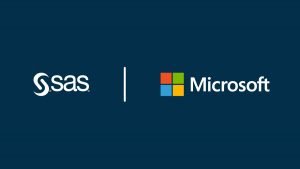 Recently, we announced a strategic partnership between SAS and Microsoft that includes deep integration for SAS technologies across all three of Microsoft’s clouds: Azure, Microsoft 365 and Dynamics 365. As migration of data to the cloud continues to increase, SAS is engineering our software to work in the cloud through deep technology integrations with native cloud services.
Recently, we announced a strategic partnership between SAS and Microsoft that includes deep integration for SAS technologies across all three of Microsoft’s clouds: Azure, Microsoft 365 and Dynamics 365. As migration of data to the cloud continues to increase, SAS is engineering our software to work in the cloud through deep technology integrations with native cloud services.
We’ve received feedback from many SAS and Microsoft customers who are excited about the partnership. In particular, I’d like to discuss the benefits for enterprise users, developers and entrepreneurs.
1. Enterprise users
 Most enterprise customers who are not already in the cloud tell us they will be migrating there soon. SAS’ enterprise customers who select Microsoft as their preferred cloud provider will be moving large implementations of a variety of applications – including analytics, machine learning and artificial intelligence workloads – to Azure. These include applications for supply chain optimization, fraud prevention and IoT projects.
Most enterprise customers who are not already in the cloud tell us they will be migrating there soon. SAS’ enterprise customers who select Microsoft as their preferred cloud provider will be moving large implementations of a variety of applications – including analytics, machine learning and artificial intelligence workloads – to Azure. These include applications for supply chain optimization, fraud prevention and IoT projects.
Often these types of projects involve transactional capabilities supplied by one vendor while SAS provides reporting, analytics, machine learning and AI. A typical configuration has two sets of data: one for transactional and one for reporting. In the cloud, we can combine those two data sets into an orchestrated whole, making analytics a critical part of the business landscape.
In many of these implementations, companies source data from a wide variety of applications and data sets, relying on Azure Synapse Analytics as a common business analytics service regardless of their data warehousing or big data needs. Customers can use the combination of existing Active Directory capabilities through Azure with existing security layered on top that SAS provides seamlessly. For example, inside Active Directory, enterprise users can identify certain roles that get access to certain data sets; the SAS internal security model will seamlessly integrate and fully support those definitions.
SAS will take advantage of all these features by ingesting and consuming data for analytics purposes. In the future, the SAS® Analytics engine will be able to run behind Power BI and be orchestrated by Power Automate, delivering real-time analytics for decision making or consumption by other applications for greater operational efficiency.
2. Developers

Builders of SAS solutions and applications with the desire to share data or integrate those solutions via standard APIs are embracing the Microsoft Clouds. We refer to these types of applications as cloud native, and SAS supports the way the cloud provider consumes their cloud services. Customers benefit from this since data that may reside inside or outside their organization is accessible through native Microsoft services such as those found in Synapse.
For example, a SAS developer at a global telecom company can share an application that reduces churn to each of its subsidiaries to use in their regions. Even if the definition of churn differs from region to region and each of the regional models requires slight modifications, the models will be supported. SAS Model Manager keeps track of the different models and the changes in a single place. In addition, SAS Model Manager will recognize those subtle differences and can allow the enterprise to have an aggregated view of churn, using the various regional definitions.
Often when developers build an application using the SAS Platform, their focus is on performance and access to data. Placing this application in the Microsoft Clouds will make it easier to share with other groups and applications within the organization.
Azure’s benefits for developers come down to simplified data modeling, a common security model using Azure Active Directory, increasing developer productivity through seamless integration to native services offered by Azure, and the ability to get at data no matter where it resides.
Likewise, developers will derive a huge advantage from Microsoft Synapse features, including data integration, to seamlessly drive streaming analytics from SAS and workload isolation if required by the customer.
3. Entrepreneurs
 SAS modelers and data scientists who have built unique algorithms to deliver to the market will find eager customers in the Microsoft cloud. If you have an idea for a new algorithm to solve a specific problem (no matter how large or small) and want to market it to others, this new partnership could be the platform you need. You might, for example, create an application for contact tracers to use in the field. Or a model that detects unemployment fraud within minutes.
SAS modelers and data scientists who have built unique algorithms to deliver to the market will find eager customers in the Microsoft cloud. If you have an idea for a new algorithm to solve a specific problem (no matter how large or small) and want to market it to others, this new partnership could be the platform you need. You might, for example, create an application for contact tracers to use in the field. Or a model that detects unemployment fraud within minutes.
Entrepreneur developers can leverage the smooth integration of Microsoft and SAS solutions for innovation now and in the future. SAS will be sponsoring hackathons for coders and entrepreneurs to raise their visibility in target markets. Our goal is to facilitate greater innovation and solutions by connecting core subject matter experts with entrepreneurs and citizen data scientists.
SAS and Microsoft partnership in action
Now that we’ve talked through these different hypothetical scenarios, let me conclude with a success story about SAS on Azure IoT right now. Here in Cary, NC, Microsoft and SAS IoT labs have worked together to deliver a flood plain management solution that monitors flood activity in real time and predicts flooding risks. The solution uses water sensor data, AccuWeather data from Azure Maps and SAS Analytics to create a digital twin of the watershed. The resulting models project the possible outcomes, including changes in the flood plain in the event of a variety of weather-related events.
So many cities and countries across the globe face similar issues with flooding. It’s easy to imagine how this solution, created by developers in North Carolina, can now be duplicated in other regions using SAS and Microsoft.
Technically, this solution demonstrates the use of SAS to integrate IoT, sensor-based technologies with Microsoft’s Azure cloud through a variety of native cloud services without having to build those integrations yourself.
What’s next? Learn more about SAS and Microsoft or attend a webinar about moving SAS to Azure.


1 Comment
Super list .. really helpful. Bookmarking this post.